Comprehensive Brand Management Report: Apple Inc. Case Study
VerifiedAdded on 2020/07/22
|13
|3904
|55
Report
AI Summary
This report provides a comprehensive analysis of Apple Inc.'s brand management strategies. It begins by examining the importance of branding as a marketing tool and its evolution in business practices, focusing on the creation of brand image, customer loyalty, and the differentiation of products. The report then delves into key components of successful brand strategies, including networking marketing, product launches, and follower strategies, while also discussing factors for building brand equity such as communication and awareness. Furthermore, it explores different strategies of portfolio management, brand hierarchy, and brand equity management, comparing Apple's and Samsung's approaches. The report concludes by examining various methods and tools for assessing and managing brand value, providing a complete overview of Apple's brand management techniques and their effectiveness in the competitive market.

Brand Management
Paraphrase This Document
Need a fresh take? Get an instant paraphrase of this document with our AI Paraphraser

Table of Contents
INTRODUCTION...........................................................................................................................1
TASK 1............................................................................................................................................1
P 1: Branding importance as marketing tool and the way it has emerged in business practices 1
P 2 Key components of successful brand strategies and managing brand equity.......................3
TASK 2............................................................................................................................................4
P3 Different strategies of portfolio management, brand hierarchy and brand equity
management................................................................................................................................4
TASK 3............................................................................................................................................6
P4 Brands management collaboratively and in partnership........................................................6
TASK 4............................................................................................................................................7
P5 Various kinds of methods & tools for assessing and managing brand value.........................7
CONCLUSION................................................................................................................................9
REFERENCES .............................................................................................................................10
INTRODUCTION...........................................................................................................................1
TASK 1............................................................................................................................................1
P 1: Branding importance as marketing tool and the way it has emerged in business practices 1
P 2 Key components of successful brand strategies and managing brand equity.......................3
TASK 2............................................................................................................................................4
P3 Different strategies of portfolio management, brand hierarchy and brand equity
management................................................................................................................................4
TASK 3............................................................................................................................................6
P4 Brands management collaboratively and in partnership........................................................6
TASK 4............................................................................................................................................7
P5 Various kinds of methods & tools for assessing and managing brand value.........................7
CONCLUSION................................................................................................................................9
REFERENCES .............................................................................................................................10
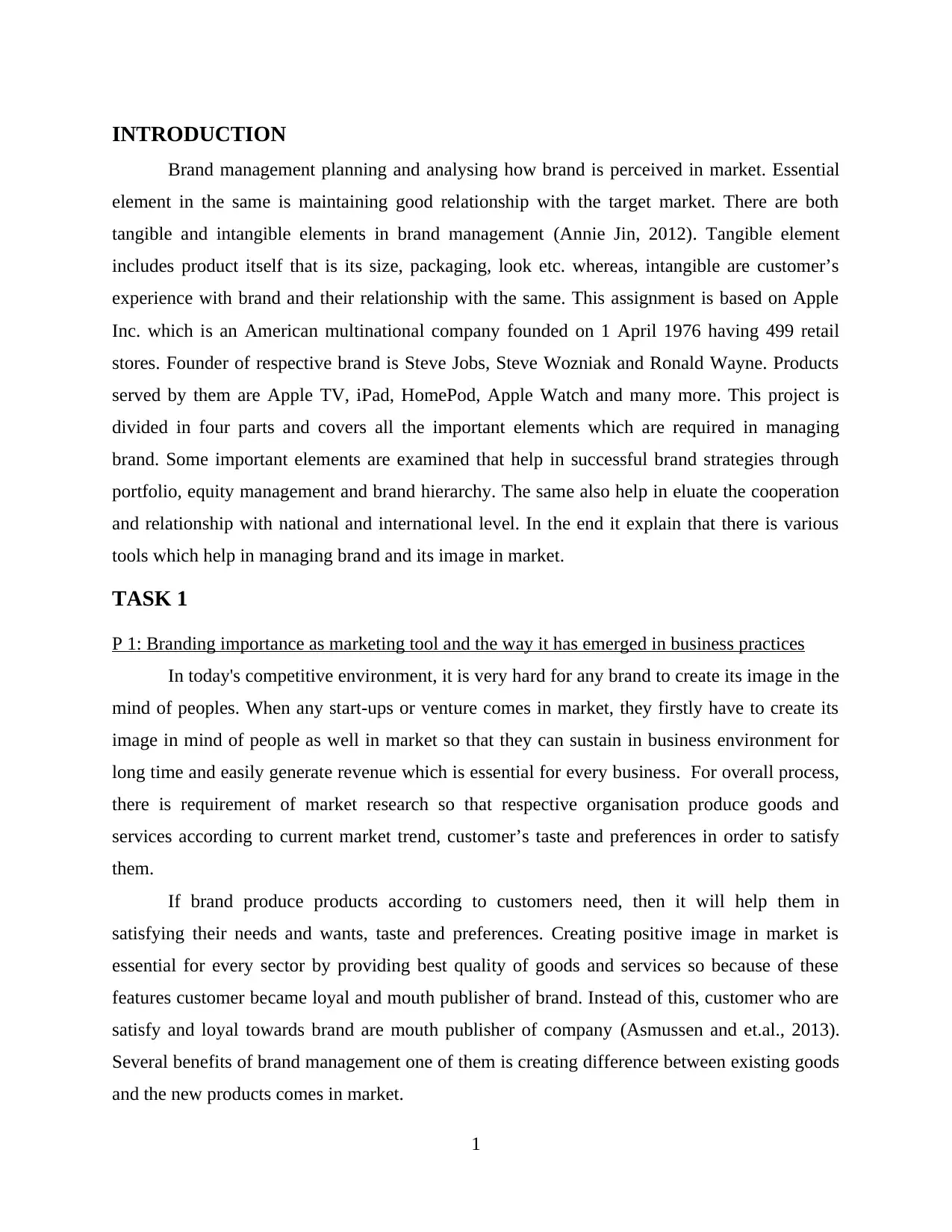
INTRODUCTION
Brand management planning and analysing how brand is perceived in market. Essential
element in the same is maintaining good relationship with the target market. There are both
tangible and intangible elements in brand management (Annie Jin, 2012). Tangible element
includes product itself that is its size, packaging, look etc. whereas, intangible are customer’s
experience with brand and their relationship with the same. This assignment is based on Apple
Inc. which is an American multinational company founded on 1 April 1976 having 499 retail
stores. Founder of respective brand is Steve Jobs, Steve Wozniak and Ronald Wayne. Products
served by them are Apple TV, iPad, HomePod, Apple Watch and many more. This project is
divided in four parts and covers all the important elements which are required in managing
brand. Some important elements are examined that help in successful brand strategies through
portfolio, equity management and brand hierarchy. The same also help in eluate the cooperation
and relationship with national and international level. In the end it explain that there is various
tools which help in managing brand and its image in market.
TASK 1
P 1: Branding importance as marketing tool and the way it has emerged in business practices
In today's competitive environment, it is very hard for any brand to create its image in the
mind of peoples. When any start-ups or venture comes in market, they firstly have to create its
image in mind of people as well in market so that they can sustain in business environment for
long time and easily generate revenue which is essential for every business. For overall process,
there is requirement of market research so that respective organisation produce goods and
services according to current market trend, customer’s taste and preferences in order to satisfy
them.
If brand produce products according to customers need, then it will help them in
satisfying their needs and wants, taste and preferences. Creating positive image in market is
essential for every sector by providing best quality of goods and services so because of these
features customer became loyal and mouth publisher of brand. Instead of this, customer who are
satisfy and loyal towards brand are mouth publisher of company (Asmussen and et.al., 2013).
Several benefits of brand management one of them is creating difference between existing goods
and the new products comes in market.
1
Brand management planning and analysing how brand is perceived in market. Essential
element in the same is maintaining good relationship with the target market. There are both
tangible and intangible elements in brand management (Annie Jin, 2012). Tangible element
includes product itself that is its size, packaging, look etc. whereas, intangible are customer’s
experience with brand and their relationship with the same. This assignment is based on Apple
Inc. which is an American multinational company founded on 1 April 1976 having 499 retail
stores. Founder of respective brand is Steve Jobs, Steve Wozniak and Ronald Wayne. Products
served by them are Apple TV, iPad, HomePod, Apple Watch and many more. This project is
divided in four parts and covers all the important elements which are required in managing
brand. Some important elements are examined that help in successful brand strategies through
portfolio, equity management and brand hierarchy. The same also help in eluate the cooperation
and relationship with national and international level. In the end it explain that there is various
tools which help in managing brand and its image in market.
TASK 1
P 1: Branding importance as marketing tool and the way it has emerged in business practices
In today's competitive environment, it is very hard for any brand to create its image in the
mind of peoples. When any start-ups or venture comes in market, they firstly have to create its
image in mind of people as well in market so that they can sustain in business environment for
long time and easily generate revenue which is essential for every business. For overall process,
there is requirement of market research so that respective organisation produce goods and
services according to current market trend, customer’s taste and preferences in order to satisfy
them.
If brand produce products according to customers need, then it will help them in
satisfying their needs and wants, taste and preferences. Creating positive image in market is
essential for every sector by providing best quality of goods and services so because of these
features customer became loyal and mouth publisher of brand. Instead of this, customer who are
satisfy and loyal towards brand are mouth publisher of company (Asmussen and et.al., 2013).
Several benefits of brand management one of them is creating difference between existing goods
and the new products comes in market.
1
⊘ This is a preview!⊘
Do you want full access?
Subscribe today to unlock all pages.

Trusted by 1+ million students worldwide
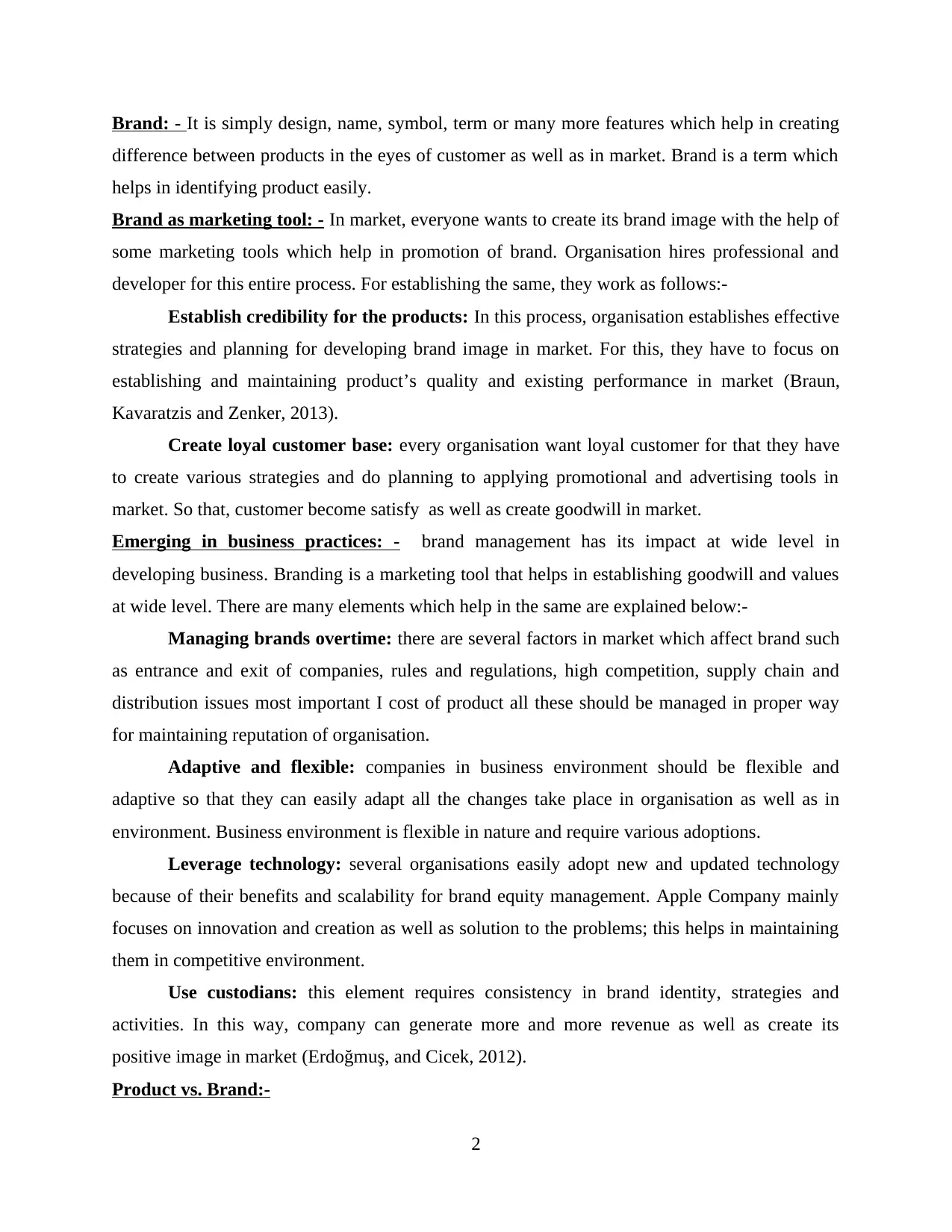
Brand: - It is simply design, name, symbol, term or many more features which help in creating
difference between products in the eyes of customer as well as in market. Brand is a term which
helps in identifying product easily.
Brand as marketing tool: - In market, everyone wants to create its brand image with the help of
some marketing tools which help in promotion of brand. Organisation hires professional and
developer for this entire process. For establishing the same, they work as follows:-
Establish credibility for the products: In this process, organisation establishes effective
strategies and planning for developing brand image in market. For this, they have to focus on
establishing and maintaining product’s quality and existing performance in market (Braun,
Kavaratzis and Zenker, 2013).
Create loyal customer base: every organisation want loyal customer for that they have
to create various strategies and do planning to applying promotional and advertising tools in
market. So that, customer become satisfy as well as create goodwill in market.
Emerging in business practices: - brand management has its impact at wide level in
developing business. Branding is a marketing tool that helps in establishing goodwill and values
at wide level. There are many elements which help in the same are explained below:-
Managing brands overtime: there are several factors in market which affect brand such
as entrance and exit of companies, rules and regulations, high competition, supply chain and
distribution issues most important I cost of product all these should be managed in proper way
for maintaining reputation of organisation.
Adaptive and flexible: companies in business environment should be flexible and
adaptive so that they can easily adapt all the changes take place in organisation as well as in
environment. Business environment is flexible in nature and require various adoptions.
Leverage technology: several organisations easily adopt new and updated technology
because of their benefits and scalability for brand equity management. Apple Company mainly
focuses on innovation and creation as well as solution to the problems; this helps in maintaining
them in competitive environment.
Use custodians: this element requires consistency in brand identity, strategies and
activities. In this way, company can generate more and more revenue as well as create its
positive image in market (Erdoğmuş, and Cicek, 2012).
Product vs. Brand:-
2
difference between products in the eyes of customer as well as in market. Brand is a term which
helps in identifying product easily.
Brand as marketing tool: - In market, everyone wants to create its brand image with the help of
some marketing tools which help in promotion of brand. Organisation hires professional and
developer for this entire process. For establishing the same, they work as follows:-
Establish credibility for the products: In this process, organisation establishes effective
strategies and planning for developing brand image in market. For this, they have to focus on
establishing and maintaining product’s quality and existing performance in market (Braun,
Kavaratzis and Zenker, 2013).
Create loyal customer base: every organisation want loyal customer for that they have
to create various strategies and do planning to applying promotional and advertising tools in
market. So that, customer become satisfy as well as create goodwill in market.
Emerging in business practices: - brand management has its impact at wide level in
developing business. Branding is a marketing tool that helps in establishing goodwill and values
at wide level. There are many elements which help in the same are explained below:-
Managing brands overtime: there are several factors in market which affect brand such
as entrance and exit of companies, rules and regulations, high competition, supply chain and
distribution issues most important I cost of product all these should be managed in proper way
for maintaining reputation of organisation.
Adaptive and flexible: companies in business environment should be flexible and
adaptive so that they can easily adapt all the changes take place in organisation as well as in
environment. Business environment is flexible in nature and require various adoptions.
Leverage technology: several organisations easily adopt new and updated technology
because of their benefits and scalability for brand equity management. Apple Company mainly
focuses on innovation and creation as well as solution to the problems; this helps in maintaining
them in competitive environment.
Use custodians: this element requires consistency in brand identity, strategies and
activities. In this way, company can generate more and more revenue as well as create its
positive image in market (Erdoğmuş, and Cicek, 2012).
Product vs. Brand:-
2
Paraphrase This Document
Need a fresh take? Get an instant paraphrase of this document with our AI Paraphraser

Brand Product
Brand is simply customer’s perception,
experience and also their expectation to
particular product and services.
Company are the one who produce products
and they sell these to target audience in
exchange of money.
These can be timeless. Whereas, they generally become a outdated in
effectual manner.
Brand is a unique value; no other can copy
each other’s product or services served by a
particular company.
These can be copied by competitors and they
launch substitute of the same in market.
P 2 Key components of successful brand strategies and managing brand equity
Company mainly focuses on building image and values of brand as well as in creating
goodwill of the same which is very important for surviving in competitive business environment.
This entire process is based on experience, perception and expectation of customers related to
particular goods and services (Hutter and et.al., 2013). Several organisations use various
strategies and techniques which help them in creating brand values and images in market along
with loyal customers who they help in doing mouth publicity as well as in generating revenue as
much as they can. Apple is famous and popular company that deals in many products and always
come with new innovation or with some latest product which easily captures market. This
company serves worldwide and having good image and loyal customers in market. Qualitative
measurement is the one which helps in determining reputation of particular brand in market.
Strategies that support in increasing brand value are mentioned as follows:-
Networking Marketing: this is an important strategy used by Apple because it is the
most popular brand and people using this at worldwide level because of their product and
services quality.
Regular products launches: Apple is a popular brand which covers worldwide area and
their iPhones, Apple watches etc. are used by everywhere because of their products customer use
it and spend amount in their products.
3
Brand is simply customer’s perception,
experience and also their expectation to
particular product and services.
Company are the one who produce products
and they sell these to target audience in
exchange of money.
These can be timeless. Whereas, they generally become a outdated in
effectual manner.
Brand is a unique value; no other can copy
each other’s product or services served by a
particular company.
These can be copied by competitors and they
launch substitute of the same in market.
P 2 Key components of successful brand strategies and managing brand equity
Company mainly focuses on building image and values of brand as well as in creating
goodwill of the same which is very important for surviving in competitive business environment.
This entire process is based on experience, perception and expectation of customers related to
particular goods and services (Hutter and et.al., 2013). Several organisations use various
strategies and techniques which help them in creating brand values and images in market along
with loyal customers who they help in doing mouth publicity as well as in generating revenue as
much as they can. Apple is famous and popular company that deals in many products and always
come with new innovation or with some latest product which easily captures market. This
company serves worldwide and having good image and loyal customers in market. Qualitative
measurement is the one which helps in determining reputation of particular brand in market.
Strategies that support in increasing brand value are mentioned as follows:-
Networking Marketing: this is an important strategy used by Apple because it is the
most popular brand and people using this at worldwide level because of their product and
services quality.
Regular products launches: Apple is a popular brand which covers worldwide area and
their iPhones, Apple watches etc. are used by everywhere because of their products customer use
it and spend amount in their products.
3
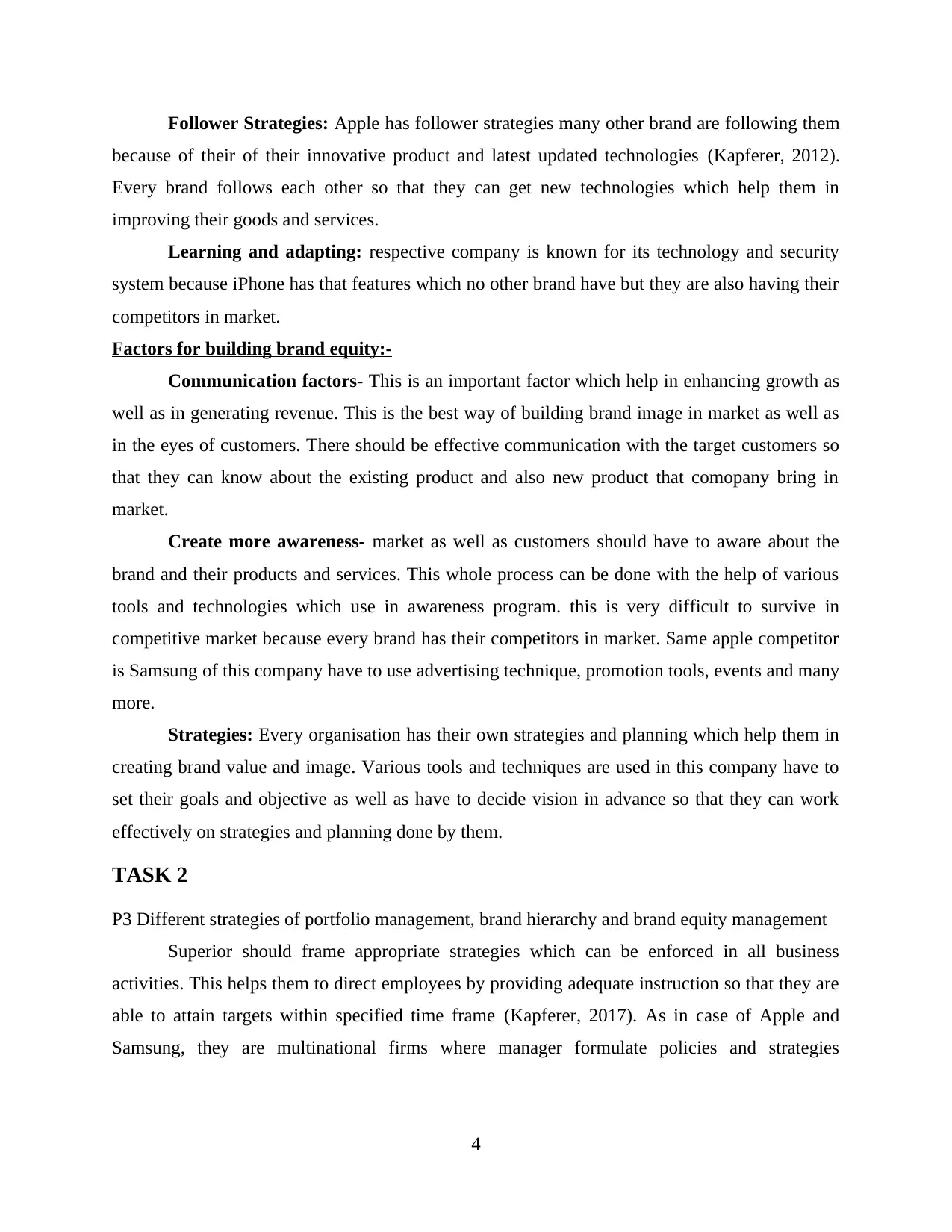
Follower Strategies: Apple has follower strategies many other brand are following them
because of their of their innovative product and latest updated technologies (Kapferer, 2012).
Every brand follows each other so that they can get new technologies which help them in
improving their goods and services.
Learning and adapting: respective company is known for its technology and security
system because iPhone has that features which no other brand have but they are also having their
competitors in market.
Factors for building brand equity:-
Communication factors- This is an important factor which help in enhancing growth as
well as in generating revenue. This is the best way of building brand image in market as well as
in the eyes of customers. There should be effective communication with the target customers so
that they can know about the existing product and also new product that comopany bring in
market.
Create more awareness- market as well as customers should have to aware about the
brand and their products and services. This whole process can be done with the help of various
tools and technologies which use in awareness program. this is very difficult to survive in
competitive market because every brand has their competitors in market. Same apple competitor
is Samsung of this company have to use advertising technique, promotion tools, events and many
more.
Strategies: Every organisation has their own strategies and planning which help them in
creating brand value and image. Various tools and techniques are used in this company have to
set their goals and objective as well as have to decide vision in advance so that they can work
effectively on strategies and planning done by them.
TASK 2
P3 Different strategies of portfolio management, brand hierarchy and brand equity management
Superior should frame appropriate strategies which can be enforced in all business
activities. This helps them to direct employees by providing adequate instruction so that they are
able to attain targets within specified time frame (Kapferer, 2017). As in case of Apple and
Samsung, they are multinational firms where manager formulate policies and strategies
4
because of their of their innovative product and latest updated technologies (Kapferer, 2012).
Every brand follows each other so that they can get new technologies which help them in
improving their goods and services.
Learning and adapting: respective company is known for its technology and security
system because iPhone has that features which no other brand have but they are also having their
competitors in market.
Factors for building brand equity:-
Communication factors- This is an important factor which help in enhancing growth as
well as in generating revenue. This is the best way of building brand image in market as well as
in the eyes of customers. There should be effective communication with the target customers so
that they can know about the existing product and also new product that comopany bring in
market.
Create more awareness- market as well as customers should have to aware about the
brand and their products and services. This whole process can be done with the help of various
tools and technologies which use in awareness program. this is very difficult to survive in
competitive market because every brand has their competitors in market. Same apple competitor
is Samsung of this company have to use advertising technique, promotion tools, events and many
more.
Strategies: Every organisation has their own strategies and planning which help them in
creating brand value and image. Various tools and techniques are used in this company have to
set their goals and objective as well as have to decide vision in advance so that they can work
effectively on strategies and planning done by them.
TASK 2
P3 Different strategies of portfolio management, brand hierarchy and brand equity management
Superior should frame appropriate strategies which can be enforced in all business
activities. This helps them to direct employees by providing adequate instruction so that they are
able to attain targets within specified time frame (Kapferer, 2017). As in case of Apple and
Samsung, they are multinational firms where manager formulate policies and strategies
4
⊘ This is a preview!⊘
Do you want full access?
Subscribe today to unlock all pages.

Trusted by 1+ million students worldwide

professionally. This benefits both companies to enhance profitability by improving productivity
and utilising resources efficiently.
Portfolio management: It presents series of exercises that will be functioned in
organisation through which administration will accomplish outcomes set by executives (Kelley,
Sheehan and Jugenheimer, 2015). Managers frame strategies through which they are able to
regulate and maintain portfolio of their items. As a result, this will help them to attract large
number of customers by delivering variety of products. Fundamentally, portfolio management
consists of two types which companies can adopt according to their system operations are as
follows: Active portfolio management strategy: Superior using this policy is required to have
complete information about market trends and changes that take place in economy. This
helps them to organise business activities in accordance to their competitors. So, manager
adopting this strategy has to take care that their firm possess good amount of share in
market. Henceforth, by taking risk, administration will be able to increase their
profitability.
Passive portfolio management strategy: Management adapting this tactic don't take risk
as they know that they will not be able to anticipate market conditions regularly. So, they
are keeping resources constant as they want to get sufficient return.
Therefore, in Apple, superior adapt active portfolio strategy and are ready to take risk; so that
they will be able to enhance market reputation and share.
Management of Apple and Samsung, have build structure through which they are able to
differentiate between their offerings. This advantage them to maintain their brand value in
market in better way (Rosenbaum-Elliott, Percy and Pervan, 2015). Some variances which
differentiate products of Apple and Samsung are as follows:
Basis Umbrella brand Products
Apple This firm is able to sell large number
of product since it is having strong
image in market. So, they are able to
offer variety of items under its single
Companies manufacture items through
which they are able to fulfil customers
need and preferences. The main
offerings of Apple iPhone are 6, 6 plus
5
and utilising resources efficiently.
Portfolio management: It presents series of exercises that will be functioned in
organisation through which administration will accomplish outcomes set by executives (Kelley,
Sheehan and Jugenheimer, 2015). Managers frame strategies through which they are able to
regulate and maintain portfolio of their items. As a result, this will help them to attract large
number of customers by delivering variety of products. Fundamentally, portfolio management
consists of two types which companies can adopt according to their system operations are as
follows: Active portfolio management strategy: Superior using this policy is required to have
complete information about market trends and changes that take place in economy. This
helps them to organise business activities in accordance to their competitors. So, manager
adopting this strategy has to take care that their firm possess good amount of share in
market. Henceforth, by taking risk, administration will be able to increase their
profitability.
Passive portfolio management strategy: Management adapting this tactic don't take risk
as they know that they will not be able to anticipate market conditions regularly. So, they
are keeping resources constant as they want to get sufficient return.
Therefore, in Apple, superior adapt active portfolio strategy and are ready to take risk; so that
they will be able to enhance market reputation and share.
Management of Apple and Samsung, have build structure through which they are able to
differentiate between their offerings. This advantage them to maintain their brand value in
market in better way (Rosenbaum-Elliott, Percy and Pervan, 2015). Some variances which
differentiate products of Apple and Samsung are as follows:
Basis Umbrella brand Products
Apple This firm is able to sell large number
of product since it is having strong
image in market. So, they are able to
offer variety of items under its single
Companies manufacture items through
which they are able to fulfil customers
need and preferences. The main
offerings of Apple iPhone are 6, 6 plus
5
Paraphrase This Document
Need a fresh take? Get an instant paraphrase of this document with our AI Paraphraser
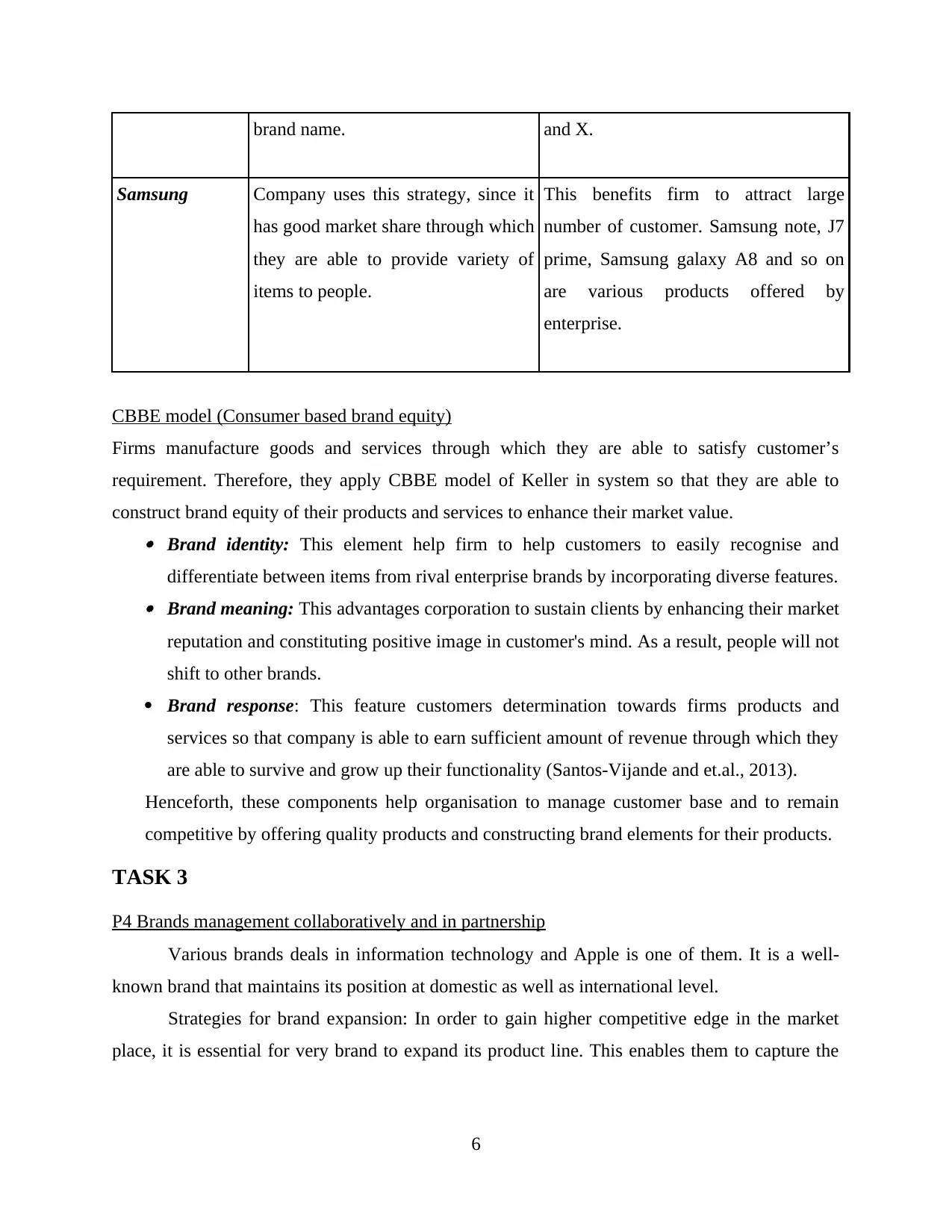
brand name. and X.
Samsung Company uses this strategy, since it
has good market share through which
they are able to provide variety of
items to people.
This benefits firm to attract large
number of customer. Samsung note, J7
prime, Samsung galaxy A8 and so on
are various products offered by
enterprise.
CBBE model (Consumer based brand equity)
Firms manufacture goods and services through which they are able to satisfy customer’s
requirement. Therefore, they apply CBBE model of Keller in system so that they are able to
construct brand equity of their products and services to enhance their market value. Brand identity: This element help firm to help customers to easily recognise and
differentiate between items from rival enterprise brands by incorporating diverse features. Brand meaning: This advantages corporation to sustain clients by enhancing their market
reputation and constituting positive image in customer's mind. As a result, people will not
shift to other brands.
Brand response: This feature customers determination towards firms products and
services so that company is able to earn sufficient amount of revenue through which they
are able to survive and grow up their functionality (Santos-Vijande and et.al., 2013).
Henceforth, these components help organisation to manage customer base and to remain
competitive by offering quality products and constructing brand elements for their products.
TASK 3
P4 Brands management collaboratively and in partnership
Various brands deals in information technology and Apple is one of them. It is a well-
known brand that maintains its position at domestic as well as international level.
Strategies for brand expansion: In order to gain higher competitive edge in the market
place, it is essential for very brand to expand its product line. This enables them to capture the
6
Samsung Company uses this strategy, since it
has good market share through which
they are able to provide variety of
items to people.
This benefits firm to attract large
number of customer. Samsung note, J7
prime, Samsung galaxy A8 and so on
are various products offered by
enterprise.
CBBE model (Consumer based brand equity)
Firms manufacture goods and services through which they are able to satisfy customer’s
requirement. Therefore, they apply CBBE model of Keller in system so that they are able to
construct brand equity of their products and services to enhance their market value. Brand identity: This element help firm to help customers to easily recognise and
differentiate between items from rival enterprise brands by incorporating diverse features. Brand meaning: This advantages corporation to sustain clients by enhancing their market
reputation and constituting positive image in customer's mind. As a result, people will not
shift to other brands.
Brand response: This feature customers determination towards firms products and
services so that company is able to earn sufficient amount of revenue through which they
are able to survive and grow up their functionality (Santos-Vijande and et.al., 2013).
Henceforth, these components help organisation to manage customer base and to remain
competitive by offering quality products and constructing brand elements for their products.
TASK 3
P4 Brands management collaboratively and in partnership
Various brands deals in information technology and Apple is one of them. It is a well-
known brand that maintains its position at domestic as well as international level.
Strategies for brand expansion: In order to gain higher competitive edge in the market
place, it is essential for very brand to expand its product line. This enables them to capture the
6

market share of untouched market (Solomon, 2014). There are various strategies and approaches
that deal with formulation of brand extension which are defined below:
Brand Extension: Apple is considered as one of the leading and fastest growing enterprise in
the market place that renders assistance in enhancing as well as manufacturing electronic items.
Also, the cited firm deals in producing different forms of mobile phones. The recent expansion
of cited firm is Ipad.
Apart from that, there are different strategic approaches that prove to be beneficial for the cited
firm which are discussed below:
Brand Portfolio Management: Under this, development is mainly done via management in
terms of decision-making process. It is highly effective in case of promoting weak brand and
make them competitive enough as compare to its rivals.
Brand Imagination: It depicts integration of 2 or more brands with an aim of enlargement in an
effective and efficient manner.
Innovation: Apple makes effective decision in terms of doing innovation with its products. They
critically analyse the latest needs and desire of target customer and then alter their product as per
their current demand. In-fact, the cited firm has applied Ansoff’s Matrix which assists them in
framing effective plan and strategies for making their business operation more structured and
systematic.
Market Penetration: It refers to the process in which company is selling its present product to
its existing target audience. This strategy laid emphasis on increasing the sales figures which
ultimately results in accomplishing higher profits and revenues (Spear and Roper, 2013).
Brand Collaboration and Partnership: Both Cisco and Apple are facing the best experience in
terms of world's leading brand. Its new services and products are mainly in the form of MacOS
from Cisco and IOS integrations.
TASK 4
P5 Various kinds of methods & tools for assessing as well as managing brand value
All organisations have to focus on an important task and that is brand value which plays a
very essential role in market trends for maintaining productivity and profitability as well. It
seems to be necessary to expand the brand image at domestic level as well as global level to
boost up profits and sales of an enterprise. To attain growth in business career, it is necessary to
7
that deal with formulation of brand extension which are defined below:
Brand Extension: Apple is considered as one of the leading and fastest growing enterprise in
the market place that renders assistance in enhancing as well as manufacturing electronic items.
Also, the cited firm deals in producing different forms of mobile phones. The recent expansion
of cited firm is Ipad.
Apart from that, there are different strategic approaches that prove to be beneficial for the cited
firm which are discussed below:
Brand Portfolio Management: Under this, development is mainly done via management in
terms of decision-making process. It is highly effective in case of promoting weak brand and
make them competitive enough as compare to its rivals.
Brand Imagination: It depicts integration of 2 or more brands with an aim of enlargement in an
effective and efficient manner.
Innovation: Apple makes effective decision in terms of doing innovation with its products. They
critically analyse the latest needs and desire of target customer and then alter their product as per
their current demand. In-fact, the cited firm has applied Ansoff’s Matrix which assists them in
framing effective plan and strategies for making their business operation more structured and
systematic.
Market Penetration: It refers to the process in which company is selling its present product to
its existing target audience. This strategy laid emphasis on increasing the sales figures which
ultimately results in accomplishing higher profits and revenues (Spear and Roper, 2013).
Brand Collaboration and Partnership: Both Cisco and Apple are facing the best experience in
terms of world's leading brand. Its new services and products are mainly in the form of MacOS
from Cisco and IOS integrations.
TASK 4
P5 Various kinds of methods & tools for assessing as well as managing brand value
All organisations have to focus on an important task and that is brand value which plays a
very essential role in market trends for maintaining productivity and profitability as well. It
seems to be necessary to expand the brand image at domestic level as well as global level to
boost up profits and sales of an enterprise. To attain growth in business career, it is necessary to
7
⊘ This is a preview!⊘
Do you want full access?
Subscribe today to unlock all pages.

Trusted by 1+ million students worldwide
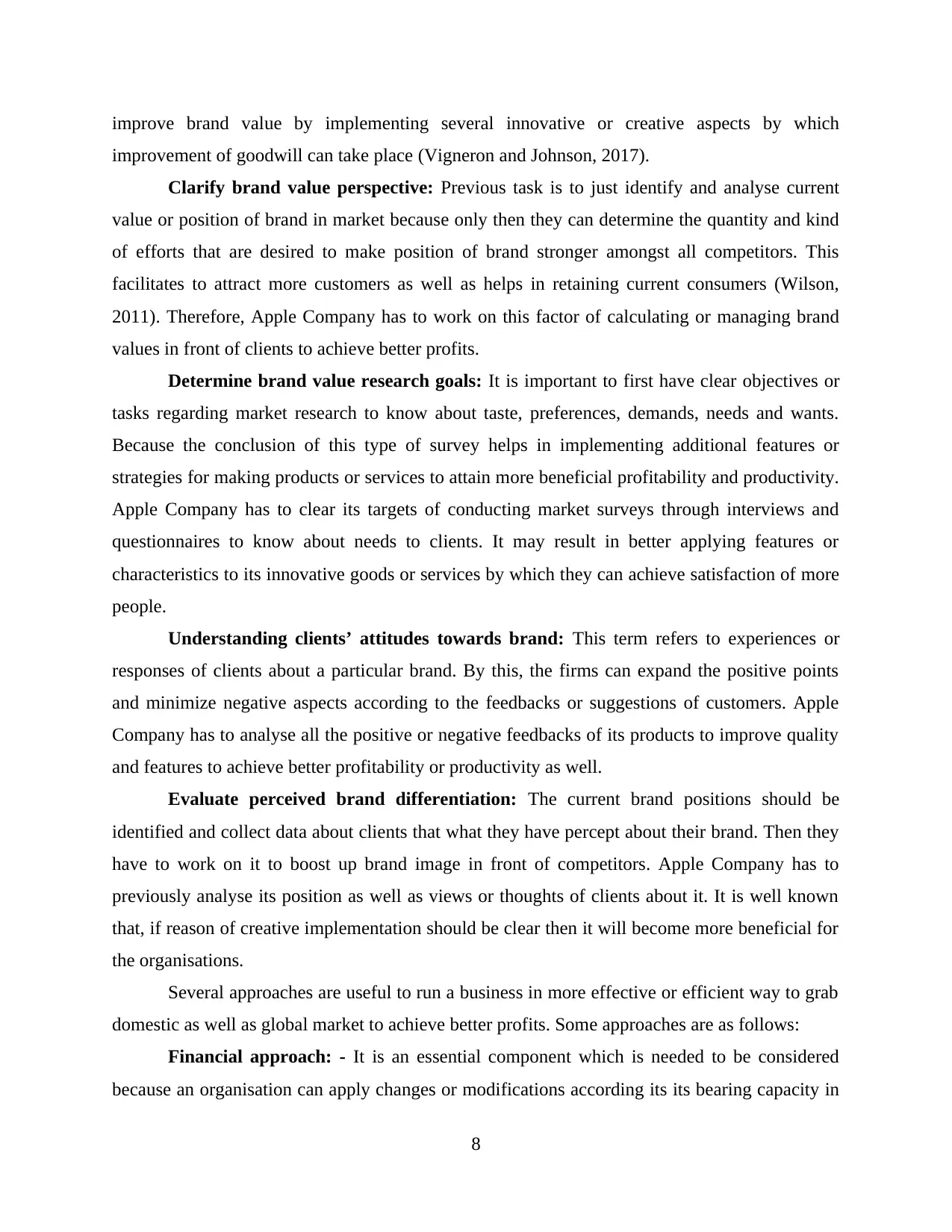
improve brand value by implementing several innovative or creative aspects by which
improvement of goodwill can take place (Vigneron and Johnson, 2017).
Clarify brand value perspective: Previous task is to just identify and analyse current
value or position of brand in market because only then they can determine the quantity and kind
of efforts that are desired to make position of brand stronger amongst all competitors. This
facilitates to attract more customers as well as helps in retaining current consumers (Wilson,
2011). Therefore, Apple Company has to work on this factor of calculating or managing brand
values in front of clients to achieve better profits.
Determine brand value research goals: It is important to first have clear objectives or
tasks regarding market research to know about taste, preferences, demands, needs and wants.
Because the conclusion of this type of survey helps in implementing additional features or
strategies for making products or services to attain more beneficial profitability and productivity.
Apple Company has to clear its targets of conducting market surveys through interviews and
questionnaires to know about needs to clients. It may result in better applying features or
characteristics to its innovative goods or services by which they can achieve satisfaction of more
people.
Understanding clients’ attitudes towards brand: This term refers to experiences or
responses of clients about a particular brand. By this, the firms can expand the positive points
and minimize negative aspects according to the feedbacks or suggestions of customers. Apple
Company has to analyse all the positive or negative feedbacks of its products to improve quality
and features to achieve better profitability or productivity as well.
Evaluate perceived brand differentiation: The current brand positions should be
identified and collect data about clients that what they have percept about their brand. Then they
have to work on it to boost up brand image in front of competitors. Apple Company has to
previously analyse its position as well as views or thoughts of clients about it. It is well known
that, if reason of creative implementation should be clear then it will become more beneficial for
the organisations.
Several approaches are useful to run a business in more effective or efficient way to grab
domestic as well as global market to achieve better profits. Some approaches are as follows:
Financial approach: - It is an essential component which is needed to be considered
because an organisation can apply changes or modifications according its its bearing capacity in
8
improvement of goodwill can take place (Vigneron and Johnson, 2017).
Clarify brand value perspective: Previous task is to just identify and analyse current
value or position of brand in market because only then they can determine the quantity and kind
of efforts that are desired to make position of brand stronger amongst all competitors. This
facilitates to attract more customers as well as helps in retaining current consumers (Wilson,
2011). Therefore, Apple Company has to work on this factor of calculating or managing brand
values in front of clients to achieve better profits.
Determine brand value research goals: It is important to first have clear objectives or
tasks regarding market research to know about taste, preferences, demands, needs and wants.
Because the conclusion of this type of survey helps in implementing additional features or
strategies for making products or services to attain more beneficial profitability and productivity.
Apple Company has to clear its targets of conducting market surveys through interviews and
questionnaires to know about needs to clients. It may result in better applying features or
characteristics to its innovative goods or services by which they can achieve satisfaction of more
people.
Understanding clients’ attitudes towards brand: This term refers to experiences or
responses of clients about a particular brand. By this, the firms can expand the positive points
and minimize negative aspects according to the feedbacks or suggestions of customers. Apple
Company has to analyse all the positive or negative feedbacks of its products to improve quality
and features to achieve better profitability or productivity as well.
Evaluate perceived brand differentiation: The current brand positions should be
identified and collect data about clients that what they have percept about their brand. Then they
have to work on it to boost up brand image in front of competitors. Apple Company has to
previously analyse its position as well as views or thoughts of clients about it. It is well known
that, if reason of creative implementation should be clear then it will become more beneficial for
the organisations.
Several approaches are useful to run a business in more effective or efficient way to grab
domestic as well as global market to achieve better profits. Some approaches are as follows:
Financial approach: - It is an essential component which is needed to be considered
because an organisation can apply changes or modifications according its its bearing capacity in
8
Paraphrase This Document
Need a fresh take? Get an instant paraphrase of this document with our AI Paraphraser
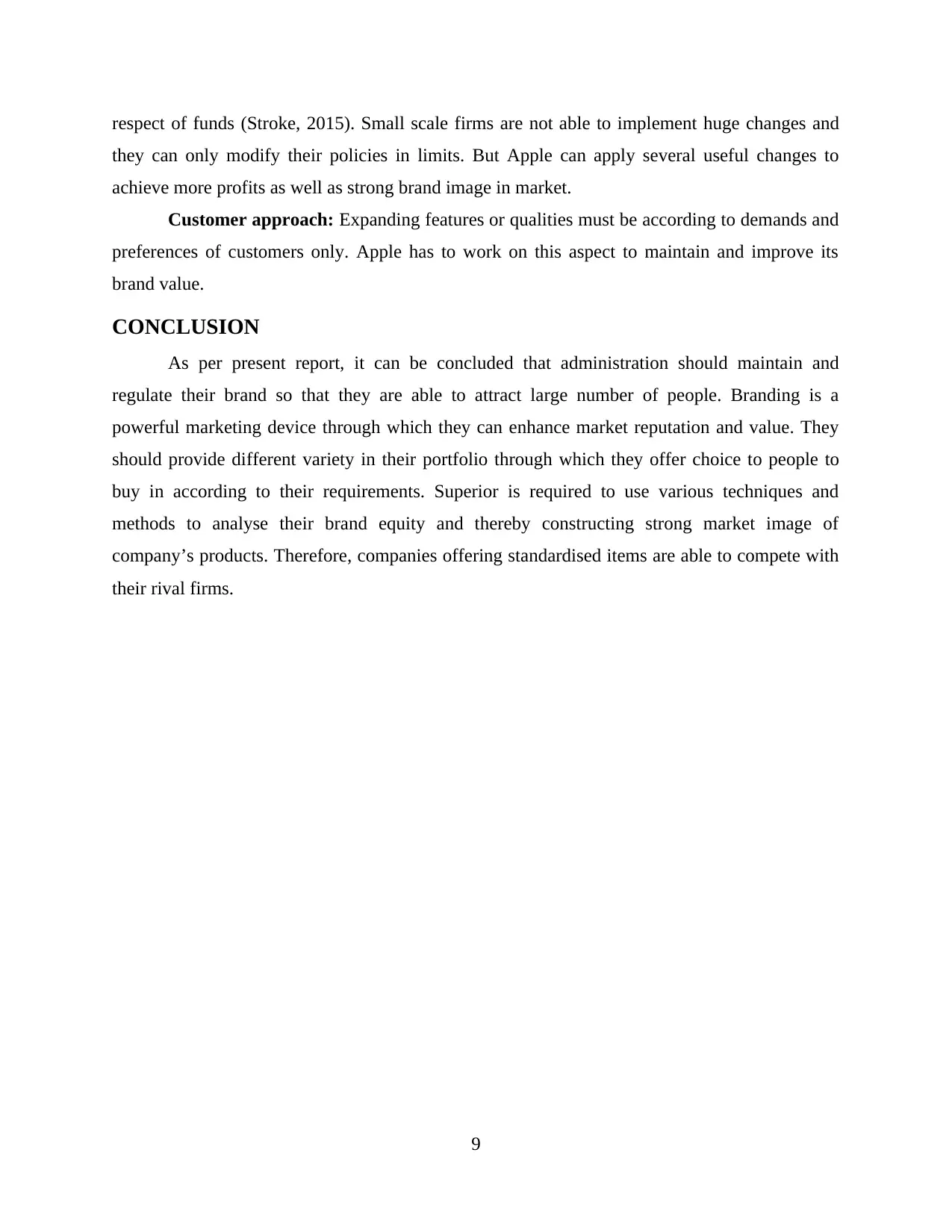
respect of funds (Stroke, 2015). Small scale firms are not able to implement huge changes and
they can only modify their policies in limits. But Apple can apply several useful changes to
achieve more profits as well as strong brand image in market.
Customer approach: Expanding features or qualities must be according to demands and
preferences of customers only. Apple has to work on this aspect to maintain and improve its
brand value.
CONCLUSION
As per present report, it can be concluded that administration should maintain and
regulate their brand so that they are able to attract large number of people. Branding is a
powerful marketing device through which they can enhance market reputation and value. They
should provide different variety in their portfolio through which they offer choice to people to
buy in according to their requirements. Superior is required to use various techniques and
methods to analyse their brand equity and thereby constructing strong market image of
company’s products. Therefore, companies offering standardised items are able to compete with
their rival firms.
9
they can only modify their policies in limits. But Apple can apply several useful changes to
achieve more profits as well as strong brand image in market.
Customer approach: Expanding features or qualities must be according to demands and
preferences of customers only. Apple has to work on this aspect to maintain and improve its
brand value.
CONCLUSION
As per present report, it can be concluded that administration should maintain and
regulate their brand so that they are able to attract large number of people. Branding is a
powerful marketing device through which they can enhance market reputation and value. They
should provide different variety in their portfolio through which they offer choice to people to
buy in according to their requirements. Superior is required to use various techniques and
methods to analyse their brand equity and thereby constructing strong market image of
company’s products. Therefore, companies offering standardised items are able to compete with
their rival firms.
9
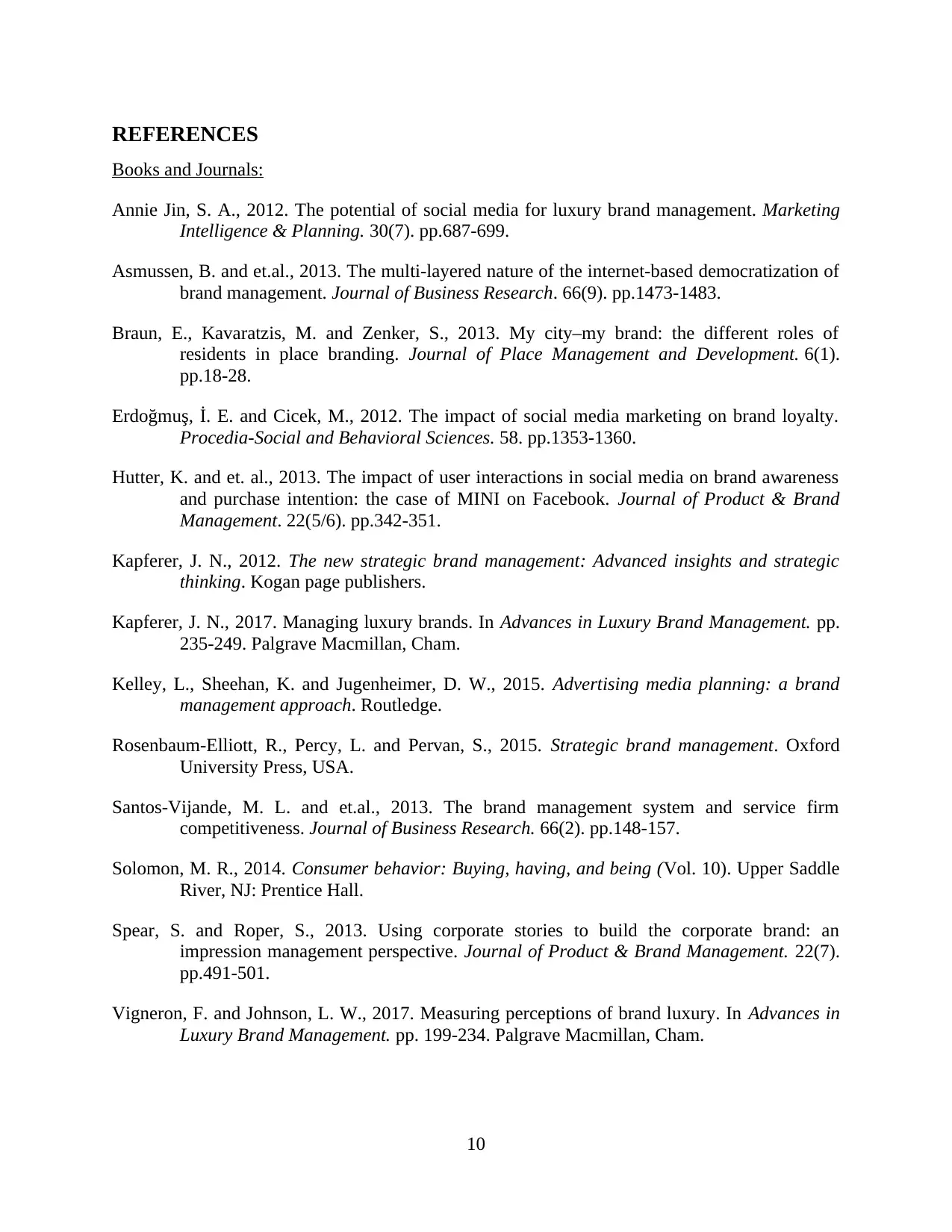
REFERENCES
Books and Journals:
Annie Jin, S. A., 2012. The potential of social media for luxury brand management. Marketing
Intelligence & Planning. 30(7). pp.687-699.
Asmussen, B. and et.al., 2013. The multi-layered nature of the internet-based democratization of
brand management. Journal of Business Research. 66(9). pp.1473-1483.
Braun, E., Kavaratzis, M. and Zenker, S., 2013. My city–my brand: the different roles of
residents in place branding. Journal of Place Management and Development. 6(1).
pp.18-28.
Erdoğmuş, İ. E. and Cicek, M., 2012. The impact of social media marketing on brand loyalty.
Procedia-Social and Behavioral Sciences. 58. pp.1353-1360.
Hutter, K. and et. al., 2013. The impact of user interactions in social media on brand awareness
and purchase intention: the case of MINI on Facebook. Journal of Product & Brand
Management. 22(5/6). pp.342-351.
Kapferer, J. N., 2012. The new strategic brand management: Advanced insights and strategic
thinking. Kogan page publishers.
Kapferer, J. N., 2017. Managing luxury brands. In Advances in Luxury Brand Management. pp.
235-249. Palgrave Macmillan, Cham.
Kelley, L., Sheehan, K. and Jugenheimer, D. W., 2015. Advertising media planning: a brand
management approach. Routledge.
Rosenbaum-Elliott, R., Percy, L. and Pervan, S., 2015. Strategic brand management. Oxford
University Press, USA.
Santos-Vijande, M. L. and et.al., 2013. The brand management system and service firm
competitiveness. Journal of Business Research. 66(2). pp.148-157.
Solomon, M. R., 2014. Consumer behavior: Buying, having, and being (Vol. 10). Upper Saddle
River, NJ: Prentice Hall.
Spear, S. and Roper, S., 2013. Using corporate stories to build the corporate brand: an
impression management perspective. Journal of Product & Brand Management. 22(7).
pp.491-501.
Vigneron, F. and Johnson, L. W., 2017. Measuring perceptions of brand luxury. In Advances in
Luxury Brand Management. pp. 199-234. Palgrave Macmillan, Cham.
10
Books and Journals:
Annie Jin, S. A., 2012. The potential of social media for luxury brand management. Marketing
Intelligence & Planning. 30(7). pp.687-699.
Asmussen, B. and et.al., 2013. The multi-layered nature of the internet-based democratization of
brand management. Journal of Business Research. 66(9). pp.1473-1483.
Braun, E., Kavaratzis, M. and Zenker, S., 2013. My city–my brand: the different roles of
residents in place branding. Journal of Place Management and Development. 6(1).
pp.18-28.
Erdoğmuş, İ. E. and Cicek, M., 2012. The impact of social media marketing on brand loyalty.
Procedia-Social and Behavioral Sciences. 58. pp.1353-1360.
Hutter, K. and et. al., 2013. The impact of user interactions in social media on brand awareness
and purchase intention: the case of MINI on Facebook. Journal of Product & Brand
Management. 22(5/6). pp.342-351.
Kapferer, J. N., 2012. The new strategic brand management: Advanced insights and strategic
thinking. Kogan page publishers.
Kapferer, J. N., 2017. Managing luxury brands. In Advances in Luxury Brand Management. pp.
235-249. Palgrave Macmillan, Cham.
Kelley, L., Sheehan, K. and Jugenheimer, D. W., 2015. Advertising media planning: a brand
management approach. Routledge.
Rosenbaum-Elliott, R., Percy, L. and Pervan, S., 2015. Strategic brand management. Oxford
University Press, USA.
Santos-Vijande, M. L. and et.al., 2013. The brand management system and service firm
competitiveness. Journal of Business Research. 66(2). pp.148-157.
Solomon, M. R., 2014. Consumer behavior: Buying, having, and being (Vol. 10). Upper Saddle
River, NJ: Prentice Hall.
Spear, S. and Roper, S., 2013. Using corporate stories to build the corporate brand: an
impression management perspective. Journal of Product & Brand Management. 22(7).
pp.491-501.
Vigneron, F. and Johnson, L. W., 2017. Measuring perceptions of brand luxury. In Advances in
Luxury Brand Management. pp. 199-234. Palgrave Macmillan, Cham.
10
⊘ This is a preview!⊘
Do you want full access?
Subscribe today to unlock all pages.

Trusted by 1+ million students worldwide
1 out of 13
Related Documents
Your All-in-One AI-Powered Toolkit for Academic Success.
+13062052269
info@desklib.com
Available 24*7 on WhatsApp / Email
![[object Object]](/_next/static/media/star-bottom.7253800d.svg)
Unlock your academic potential
Copyright © 2020–2025 A2Z Services. All Rights Reserved. Developed and managed by ZUCOL.





